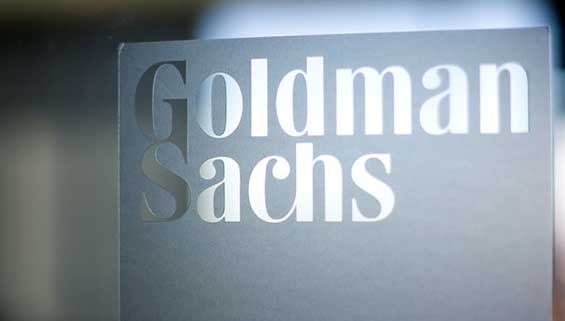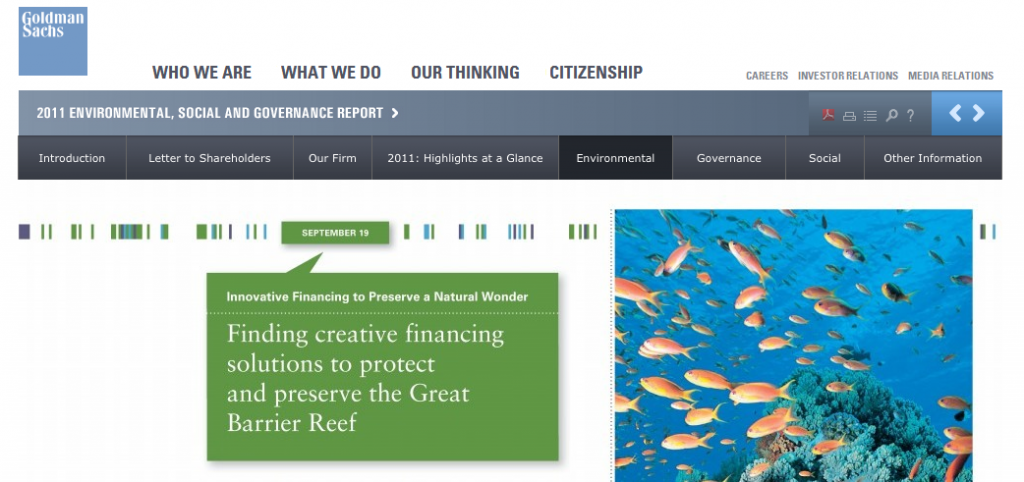 Last week I received an announcement from Goldman Sachs proudly promoting their latest Corporate Social Responsibility (CSR) report, highlighting efforts to address environmental, social and governance issues in 2011 and an ongoing commitment to clean energy financing.
Last week I received an announcement from Goldman Sachs proudly promoting their latest Corporate Social Responsibility (CSR) report, highlighting efforts to address environmental, social and governance issues in 2011 and an ongoing commitment to clean energy financing.
At first glance, this perhaps sounds good — the optimistic side of me wants to feel some sign of progress that groups like RAN, BankTrack, and our many allies have raised environmental issues high enough on the banking agenda for Goldman Sachs to be putting their resources these initiatives.
But when I scratch the varnish on this announcement, my pessimistic side takes over. Goldman’s flagship clean energy commitment — a new target to make $40 billion energy investments or financing over the next ten years — lacks ambition. It is actually a step backwards, implying a lower level of financing than in the previous six years.
The average $4 billion annual target is actually lower than the $4.8 billion that Goldman Sachs invested in the sector in 2011, and also less than the average of $4.6 billion since its initial environmental target was set in 2005. From that point until the end of 2011, the bank had arranged $24 billion worth of financing and invested $4 billion of its own funds into renewable energy.
But, more importantly, this commitment to renewable energy financing masks the significant amounts of money that Goldman Sachs is putting into fossil fuels, in particular coal. Here are some of the bank’s recent ‘efforts’ that the bank needs to address:
- In December 2011 Goldman Sachs was ranked the 11th worst ‘Climate Killer’ bank in terms of global coal financing in the ‘Bankrolling Climate Change’ report by BankTrack
- Goldman Sachs owns a majority share in SSA Marine, the company that is planning to build the west coast’s largest coal export terminal in Bellingham, Washington, threatening the critical ecosystem of Cherry Point Reach
- In 2010 and 2011, Goldman Sachs underwrote seven of the most polluting utility companies that operate fleets of coal-fired power plants, the single largest source of climate pollution in the U.S.
- Goldman Sachs owns and operates the Cedar Bay coal-fired power plant in Florida, which emitted 1.8 million tonnes of CO2 in 2011.
Goldman Sachs devotes pages of its new report to talking about its efforts to reduce their ‘operational’ climate emissions (those emissions that come from bank offices, staff travel etc). However, as RAN has said many times before, the most significant climate impact of any bank is the emissions of those companies and projects that the bank finances. Yet again, Goldman Sachs has avoided this topic.

The report also devotes a section to its “Creative financing solutions to protect and preserve the Great Barrier Reef”, directly quoting the IPCC’s ominous prediction that “by 2020, if nothing was done, as much as 60% of the Reef would bleach every second year”. If Goldman Sachs is truly serious about saving the Reef and our climate, then the first obvious step is to get out of bed with the coal industry, and to set some serious financed-emissions reduction targets.